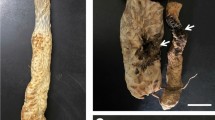Abstract
Colletotrichum falcatum pathotypes exhibit distinct differential host interaction where certain pathotypes specifically infect their adapted host cultivars. This adaptation phenomenon was tested with two distinct pathotypes,viz. Cf1148 and Cf7717 isolated from cultivars Co 1148 and Co 7717, respectively. The results revealed that pathogenicity of both the pathotypes was influenced by their respective/host specific parental cultivars and not vice versa. Cane juice from the host cultivars influenced cultural characters of the pathogen including mycelial growth and conidial germination and they were also varied depending on juice from position of cane stalk. Adaptability of Cf1148 and Cf7717 was tested by cross inoculation on their incompatible hosts viz. Co 7717 and Co 1148, respectively. On cross inoculation, restricted symptoms were produced. Reisolation from such canes yielded fungal activity with changes in growth pattern as compared to original cultures was noticed. After repeated inoculations the dark isolates at initial phases become light with increased sporulation on their adapted hosts. Development of light isolates and reduced latent period for symptom expression by repeated inoculations on incompatible hosts indicated the increased virulence or pathogenicity of that pathotype for adaptation on a particular cultivar.
Similar content being viewed by others
References
Abbott, E. V. (1938). Red rot of sugarcane. Tech. Bull USDA, 641, p96.
Abbott, E. V.and Hughes, C. G. (1961). Red rot. In: Sugarcane Diseases of the World Vol., (Eds) J. P. Martin, E. V. Abbott and C. G. Hughes, Elsevier, Amsterdam, pp 262–287.
Alexander, K. C.and Viswanathan, R. (2002). Diseases of sugarcane in India and its rapid diagnosis. In:Sugarcane Crop Management, (Eds. S. B. Singh, G. P. Rao, S. Eswaramoorthy), SCI TECH Publishing LLC, Houston, Texas, USA, pp 10–51.
Chona, B. L.and Padwick, W. G. (1942). More light on the red rot epidemic.Indian Farming,3 70–3.
Meade, C. (1977). Cane sugar handbook. A Wiley Interscience Publication ial stage ofColletotrichum falcatum Went in India. Indial Phytopath., 5: 158–160., John Wiley and Sons., New York. 947p.
Malik, C. Pand Singh, M. B. (1980). In: Plant Enzymology and Host Enzymology, Kalyani Publishers, New Delhi, P. 286.
Mohanraj, D.,Kumaresan, S.and Sreenivasan, T. V. (2002). Molecular characterization of isolates of the sugarcane red rot pathogenColletotrichum falcatum Went.Indian Phytopath.,55: 147–151.
Neill, O. N. R.and Bauchan, G. R. (2000). Sources of resistance to anthracnose in the annualMedicago core collection.Plant Dis. 84: 261–267.
Rafay, S. A.and Singh, V. B. (1957). A new strain of Glomerella tucumanensis.Curr. Sci.,10: 25–26.
Srinivasan, K. V. (1962). Some observations on variation in the red rot pathogen, Glomerella tucumanensis (Speg.) Arx and Muller. Proc.ISSCT,11: 795–802.
Srinivasan, K. V. (1963). Sporulation of the sugarcane red rot pathogen on the juice of varieties of varying resistance.Science and Culture,29: 87–88.
Srinivasan, K. V.and Bhat, N. R. (1961). Red rot of sugarcane: Criteria Red rot disease for grading resistance.Journal of Indian Botanical Society,40: 566–577.
Viswanathan, R.and Samiyappan, R. (2000). in sugarcane: Challenges and prospects.Madras Agric. J.,87: 549–559.
Viswanathan, R.,Padmanaban, P.,Mohanraj, D.and Jothi, R. (2000). Indirect -ELIS A technique for the detection of the red rot pathogen in sugarcane(Saccharum spp hybrid) and resistance screening.Indian J. Agric Sci.,70: 308–311.
Viswanathan, R.,Malathi, P.and Padmanaban, P. (2003). Variation in sugarcane red rot pathogenColletotrichum falcatum Went. In:Frontiers of Fungal Diversity in India. (Eds G. P. Rao, C. Manoharachari, D. J. Bhat, R. C. Rajak and T. N. Lakhanpal), International Book Distributing Co, Lucknow, pp639–667.
Author information
Authors and Affiliations
Corresponding author
Rights and permissions
About this article
Cite this article
Malathi, P., Viswanathan, R. & Jothi, R. Specific adaptation of colletotrichum falcatum pathotypes to sugarcane cultivars. Sugar Tech 8, 54–58 (2006). https://doi.org/10.1007/BF02943742
Received:
Accepted:
Published:
Issue Date:
DOI: https://doi.org/10.1007/BF02943742




